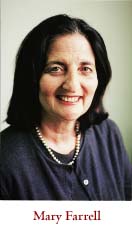


|
When Learning Doesn’t Come Naturally By Rebecca Maxon and Angelo CarfagnaTrying to better understand the disorders called “learning disabilities,” I ask professor Ron Dumont what it would feel like to be a young student suffering from such a problem. He’s heard the question many times and is prepared to convey some sense of the difficulties involved. “Switch the pen from your right hand to your left hand and continue taking notes,” he directs. Staring in a dumbfounded manner, I think, “How can any learning take place if I can’t record the information correctly?” The analogy may not be totally precise, but the principle that my learning would be derailed by breakdowns in processing and expressing information comes through loud and clear. I nod with an instant, although certainly still not exact, understanding of the frustration daily experienced by children — as well as adults — with learning disabilities. I’m relieved I can quickly pull the plug on the experiment. Millions, though, do not have that luxury. — A.C. What Is a Learning Disability?FDU experts estimate that approximately 10 percent of elementary and high school students have some type of learning disability. Of those afflicted, most experience problems with reading; in fact, about 80 percent of children with learning disabilities have difficulty reading. Identifying those students, though, is difficult, primarily because many experts disagree about what constitutes a learning disability. |
|

|
Ron Dumont is associate professor of psychology and director of FDU’s master’s and doctoral programs in school psychology. His research has been focused on the identification of learning disabilities, and he is the co-author of the New York edition of the Guide to Identification of Learning Disabilities as well as numerous articles on the subject. He says, “Many disagree on the precise definition of a learning disability, but the best we have is the one accepted as federal law and that is what should be our focus.” According to the federal regulations, a learning disability is “a disorder in one or more basic psychological processes involved in understanding or in using language, spoken or written, which manifests itself as an imperfect ability to listen, think, speak, read, write, spell or do mathematical calculations. The term includes such conditions as perceptual handicaps, brain injury, neurological impairment, minimal brain dysfunction, dyslexia and developmental aphasia. The term does not include students who have learning problems which are primarily the result of visual, hearing or motor handicaps, of mental retardation, of emotional disturbance or of environmental, cultural or economic disadvantage.” Those categorized as having a learning disability are entitled to accommodations under the Individuals with Disabilities Education Act (IDEA). “Learning disabilities,” says nationally renowned educator Loring Brinckerhoff, “is actually just a big umbrella term that refers to brain processing disorders.” Brinckerhoff, who recently gave a workshop on the subject for FDU faculty and staff, is the author of Post-secondary Education and Transition for Students with Learning Disabilities.
He points out that most students with learning disabilities are of average and above average intelligence. Those with learning disabilities, he adds, have trouble taking in, retrieving or expressing information. Common names used to describe particular problems include dyslexia (from the Greek meaning difficulty with words), dyscalculia (problems with mathematics) and dysgraphia (difficulty with writing). Contrary to many people’s assumptions, Attention Deficit Hyperactivity Disorder (ADHD) is not classified as a learning disability (see “ADHD — Beyond the Myths”). While learning disabilities are not curable, many with these conditions can be taught to compensate effectively. In fact, some of history’s greatest thinkers, including Albert Einstein and Thomas Edison, had learning disabilities. Although questions remain about the causes of learning disabilities, many believe the problem is genetic. According to the American Academy of Pediatrics, other risk factors include low birth weight, infections of the central nervous system and severe head injuries. Among the most common characteristics displayed by students with learning disabilities, says Brinckerhoff, are: 1) verbal skills that outpace other skills like writing, 2) poor organizational skills, 3) problems with spelling and handwriting, 4) difficulty grasping abstract ideas, and 5) trouble concentrating. Frustrations EnsueAs pointed out in Dumont’s introductory example, frustrations can ensue from such difficulties. “Those who suffer from having a learning disability often feel frustrated, angry and tense. They’re frustrated because they can’t do things most other kids can do. Often they don’t understand that they have a neurological disorder and become angry with themselves and think there is something wrong with them. Finally, they are very tense in class and are scared of being called on.” |
|
|
Dumont adds that students sometimes compensate for these feelings by acting out and becoming troublemakers in an effort to divert attention from their learning difficulties. “In school the worst thing is to be called stupid, but there’s no stigma to being called a troublemaker. If such students aren’t identified as having a learning disability, they will fall further and further behind, and their behavior will continue to deteriorate.” In addition to his work at FDU, Dumont has served as a consultant with numerous school districts and has represented students during court disputes concerning evaluation findings and accommodation issues. His Web site has been praised as one of the most valuable resource centers for information on learning disabilities; it received more than 160,000 hits during the last year. Dumont agrees that most learning disabilities are related to reading. “And reading is the most important skill for young children, because if you can’t read you can’t build the foundation for future learning.” He adds that children having trouble learning to read are often diagnosed with a phonological awareness disorder. “They just don’t grasp the relationship between sounds and symbols and they cannot discriminate among sounds. They cannot differentiate between sounds like ‘weep’ and ‘veep.’” Others, he says, have trouble with skills segmenting, which is breaking up two words from one like “football,” or blending sounds together to make one word. If such problems are detected early, they can be significantly improved. For example, those who have difficulty rhyming or manipulating and changing sounds within words can be read a steady diet of Dr. Seuss books, which are bountiful in the repetition of similar sounds. Warning Signs
Mary Farrell, a professor in the Peter Sammartino School of education and director of FDU’s learning disabilities programs (see “Learning to Teach Those with Learning Disabilities”) and the Center for Clinical Teaching, says parents can look for several warning signs. “Late language acquisition, including slow or unusual development of vocabulary, may indicate a potential problem, however problems may not become evident until children begin school. Unexpected difficulties in learning to read and write may signal the need for professional evaluation.” Because children lag behind in one area, however, doesn’t automatically mean they have a learning disability; evaluations must be carefully conducted, must be comprehensive and must consider a variety of other factors. Children are often evaluated for everything from organizational skills to language development to peer relationships and concepts of self. Farrell says, “It is most often recommended that an interdisciplinary team consisting of a learning disabilities teacher consultant and a psychologist evaluate children and consider all aspects related to their achievements.” Farrell, who developed the Dyslexia Specialist Certificate program, is a nationally recognized expert on the diagnosis and treatment of dyslexia. Over the last four years, she has created a program with the Freemasons of New Jersey in which they provide scholarships for Orton-Gillingham training to 50 teachers each year. Farrell also developed Fairleigh Dickinson’s Regional Center for College Students with Learning Disabilities (see “Solutions for Life”). Among her numerous publications is a compendium of readings she edited, titled Support Services for Students with Learning Disabilities in Higher Education. Once the problem is defined, says Farrell, methods can be tailored to the individual situation. For example, Farrell refers to the Orton-Gillingham teaching approach for children with dyslexia as a “time-tested, research-based approach to teaching reading in an explicit and multisensory way.” The concept is based on “simultaneous input involving all senses. Students are taught by having them look at a letter, say it, hear it and perhaps trace or write it at the same time. This reinforces sound-symbol association and can greatly help those having difficulty in this area.” While dyslexia has commonly been associated with such symptoms as confusion over the direction letters face, difficulties with left and right and leaving out words when reading, in fact these problems are common in many learning disabilities. Classroom AnswersThere are many proven teaching methods and services available for those with learning disabilities. Teresa Montani, an assistant professor of education whose courses include Multisensory Mathematics Skills and Practicum in Diagnosis and Remediation of Learning Disabilities, says, “Depending on the severity, a learning disability may require placement in a self-contained classroom. There, students who have significant learning disabilities in all areas receive basically all their instruction from a single special education teacher. Someone who has a moderate learning disability may be placed in a regular education classroom and receive replacement services in a resource room in particular subject areas.” |
|
|
Montani, whose work in the field has included serving as a learning disabilities specialist for the Institute of Child Development at Hackensack University Medical Center (N.J.) and whose articles have appeared in publications including The Learning Consultant Journal, Diagnostique and The Journal of Learning Disabilities, adds that other students who have mild learning disabilities could be placed in a regular classroom and not receive any pullout services. “Instead, they may receive accommodations such as extended time with assignments or tests, permission to take a test in a separate room or visual and auditory information presented at the same time,” she says. “For example, rather than providing only verbal directions, instructions also could be written out on the chalkboard or in a handout.” The number of accommodations that can be made for students are numerous and many of them merely involve a little common sense. As Dumont says, “If a child has a mild memory disorder and can’t remember the multiplication tables, let’s put a multiplication graph on the desk. If a student has trouble spelling because of a visual memory disorder, let’s provide a Franklin [electronic] speller. Or, if a child has a word retrieval disorder, let’s give him/her some more time to answer a question. That’s how you help the kids.” The point is, adds Dumont, that different children can be helped in different ways. “We don’t all learn the same way. You have to have an individual plan, and you have to have cooperation between the parents and schools.” A little help can go a long way. As Farrell says, “Students with learning disabilities prove time and time again that, given the right support, they will succeed and make substantial contributions to society.” |
|
|
ADHD — Beyond the Myths | Learning to Teach Those with Learning Disabilities | Solutions for Life FDU Magazine Directory | Table of Contents | FDU Home Page | Alumni Home Page | Comments |
||